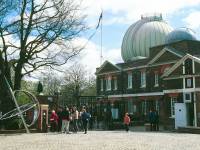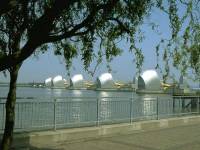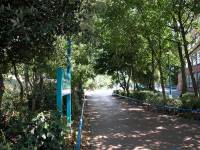

Greenwich is one of three London suburbs that just about everybody in the Western world has heard of, almost certainly without even being aware that they are London suburbs. The other two involve international sporting events and can be found within the Brent and Merton pages. Greenwich, though, basks in scientific and geographical fame. Geography might, in fact, be said to be defined here. For this is where the Earth's prime meridian, the line of zero degrees longitude, originates.
The story of how this came to be is a long one and I don't intend to give more than a brief summary here. Greenwich was originally a stretch of uninhabited Crown land on the south bank of the river several miles downstream from the City. It was laid out as a Royal park in 1433 and was the site of a Tudour Royal Palace. The commanding heights of the park made it a natural site for the Royal Observatory, founded in 1675, and it was the astronomical observations made from here that established it as the datum for the British meridian. Other great European cities, notably Paris, each had their own line of zero longitude. The multiplicity of national systems could not last, and it was at the Washington Conference of 1884 that London's Greenwich meridian was chosen as the international standard. Now, all lines of longitude are measured from here and Universal Standard Time is also defined as local time at Greenwich ("Greenwich Mean Time", or GMT).
Greenwich Park is famous not just for its observatory and its meridian. There has been a naval presence here for several centuries thanks to the extensive Naval College buildings at the foot of the park, on the site of the original royal palace. It is also from the gates on the south edge of the park that the London Marathon, the world's largest mass participation athletics event, begins at 9am on the third Sunday of April each year. And Greenwich is famed for more than its park. In a dry dock on the waterfront is the Cutty Sark, a nineteenth century tea clipper that set world speed records for tall-masted sailing ships. Beside it is the Gypsy Moth, the ocean-going yacht in which Sir Francis Chichester made the first solo circumnavigation of the world in 1967. On the Blackwall peninsula a former gasworks, one of the largest areas of derelict industrial land in Britain, is being transformed into a new residential and business district. It has as its centrepiece the Millennium Dome, the world's largest enclosed space and a structure of breathtaking elegance. And let's not forget that Greenwich town centre is a place of great charm and vitality, one of the most individual localities within the London area.
Greenwich is just one locality within the modern Borough of Greenwich, which was formed in the early Sixties by the amalgamation of the former Metropolitain boroughs of Greenwich and Woolwich. It has an area of 47 sq km (just over 15 square miles) and a population of roughly 220,000. The old Greenwich borough encompasses Greenwich itself plus the localities of Blackheath (shared with Lewisham) and Charlton; Woolwich was one of the largest of the old County of London boroughs and also includes the urban centre of Eltham as well as the Thamesmead marshes, now a new residential area. Greenwich Borough has something of an armed forces tradition, as exampled by Woolwich Arsenal and Barracks, as well as the aforementioned Greenwich Naval College and Observatory. It can boast plenty of open space, too; with Greenwich park and Blackheath Common in the west, and Oxleas Wood in the east (the nearest significant area of woodland to central London).
 |
The Millennium Dome |
 |
Greenwich Park |
 |
Thames Flood Barrier |
 |
The Capital Ring / Green Chain Walk in Greenwich |
Back to London Cityscapes index
This page last updated 2nd September 2003
![]()